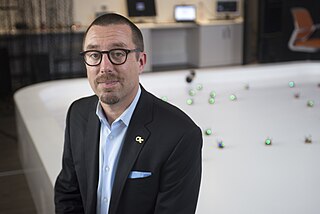Subsumption architecture is a reactive robotic architecture heavily associated with behavior-based robotics which was very popular in the 1980s and 90s. The term was introduced by Rodney Brooks and colleagues in 1986. Subsumption has been widely influential in autonomous robotics and elsewhere in real-time AI.
In computer science, a software agent or software AI is a computer program that acts for a user or other program in a relationship of agency, which derives from the Latin agere : an agreement to act on one's behalf. Such "action on behalf of" implies the authority to decide which, if any, action is appropriate. Agents are colloquially known as bots, from robot. They may be embodied, as when execution is paired with a robot body, or as software such as a chatbot executing on a phone or other computing device. Software agents may be autonomous or work together with other agents or people. Software agents interacting with people may possess human-like qualities such as natural language understanding and speech, personality or embody humanoid form.

A multi-agent system is a computerized system composed of multiple interacting intelligent agents. Multi-agent systems can solve problems that are difficult or impossible for an individual agent or a monolithic system to solve. Intelligence may include methodic, functional, procedural approaches, algorithmic search or reinforcement learning.

Swarm robotics is an approach to the coordination of multiple robots as a system which consist of large numbers of mostly simple physical robots. ″In a robot swarm, the collective behavior of the robots results from local interactions between the robots and between the robots and the environment in which they act.″ It is supposed that a desired collective behavior emerges from the interactions between the robots and interactions of robots with the environment. This approach emerged on the field of artificial swarm intelligence, as well as the biological studies of insects, ants and other fields in nature, where swarm behaviour occurs.

Stephen Grossberg is a cognitive scientist, theoretical and computational psychologist, neuroscientist, mathematician, biomedical engineer, and neuromorphic technologist. He is the Wang Professor of Cognitive and Neural Systems and a Professor Emeritus of Mathematics & Statistics, Psychological & Brain Sciences, and Biomedical Engineering at Boston University.

A mobile robot is an automatic machine that is capable of locomotion. Mobile robotics is usually considered to be a subfield of robotics and information engineering.

The International Aerial Robotics Competition (IARC) began in 1991 on the campus of the Georgia Institute of Technology and is the longest running university-based robotics competition in the world. Since 1991, collegiate teams with the backing of industry and government have fielded autonomous flying robots in an attempt to perform missions requiring robotic behaviors never before exhibited by a flying machine. In 1990, the term “aerial robotics” was coined by competition creator Robert Michelson to describe a new class of small highly intelligent flying machines. The successive years of competition saw these aerial robots grow in their capabilities from vehicles that could at first barely maintain themselves in the air, to the most recent automatons which are self-stable, self-navigating, and able to interact with their environment—especially objects on the ground.
Robotics is the branch of technology that deals with the design, construction, operation, structural disposition, manufacture and application of robots. Robotics is related to the sciences of electronics, engineering, mechanics, and software. The word "robot" was introduced to the public by Czech writer Karel Čapek in his play R.U.R., published in 1920. The term "robotics" was coined by Isaac Asimov in his 1941 science fiction short-story "Liar!"
Ekaterini Panagiotou Sycara is a Greek computer scientist. She is an Edward Fredkin Research Professor of Robotics in the Robotics Institute, School of Computer Science at Carnegie Mellon University internationally known for her research in artificial intelligence, particularly in the fields of negotiation, autonomous agents and multi-agent systems. She directs the Advanced Agent-Robotics Technology Lab at Robotics Institute, Carnegie Mellon University. She also serves as academic advisor for PhD students at both Robotics Institute and Tepper School of Business.
The School of Interactive Computing is an academic unit located within the College of Computing at the Georgia Institute of Technology. It conducts both research and teaching activities related to interactive computing at the undergraduate and graduate levels. These activities focus on computing's interaction with users and the environment, as well as how computers impact the quality of people's lives.
The Institute for Robotics and Intelligent Machines (IRIM@GT) is an interdisciplinary research unit at the Georgia Institute of Technology. The center was launched May, 2006, and consists of researchers from the School of Interactive Computing in the College of Computing, College of Engineering, and Georgia Tech Research Institute. IRIM@GT currently offers a Ph.D. program in robotics, the first truly multi-disciplinary program in the country after the one of Carnegie Mellon University.

Ayanna MacCalla Howard is an American roboticist, entrepreneur and educator currently serving as the dean of the College of Engineering at Ohio State University. Assuming the post in March 2021, Howard became the first woman to lead the Ohio State College of Engineering.

Magnus B. Egerstedt is a Swedish-American roboticist who is the Dean of the Henry Samueli School of Engineering at the University of California, Irvine. He was formerly the Steve C. Chaddick School Chair and Professor at the School of Electrical and Computer Engineering, Georgia Institute of Technology.
The Autonomous Robot Architecture (AuRA) is a hybrid deliberative/reactive robot architecture developed by American roboticist and roboethicist Ronald C. Arkin at the Georgia Institute of Technology. It was developed in mid-1980s. AuRA is one of the first Hybrid Robotic Architecture developed. Hybrid Robotic Architecture forms form combination of reactive and deliberative approaches and gets best from both the approaches.
The Guidance, Control and Decision Systems Laboratory (GCDSL) is situated in the Department of Aerospace Engineering at the Indian Institute of Science in Bangalore, India. The Mobile Robotics Laboratory (MRL) is its experimental division. They are headed by Dr. Debasish Ghose, Full Professor.
Henrik Iskov Christensen is a Danish roboticist and Professor of Computer Science at Dept. of Computer Science and Engineering, at the UC San Diego Jacobs School of Engineering. He is also the Director of the Contextual Robotics Institute at UC San Diego.
The Institute of Robotics and Intelligent Systems (IRIS) is part of the ETH Zurich, Switzerland. It replaced the existing Institute of Robotics, of the ETH Zurich in October 2002, when Prof. Bradley J. Nelson moved from the University of Minnesota, United States, to ETH Zurich and succeeded the Prof. Dr. Gerhard Schweitzer.

In artificial intelligence research, the situated approach builds agents that are designed to behave effectively successfully in their environment. This requires designing AI "from the bottom-up" by focussing on the basic perceptual and motor skills required to survive. The situated approach gives a much lower priority to abstract reasoning or problem-solving skills.

Gyula Mester is a Hungarian scientist and Professor of Robotics at the University of Szeged. He is a member of the Hungarian Academy of Engineering.

Aude G. Billard is a Swiss physicist in the fields of machine learning and human-robot interactions. As a full professor at the School of Engineering at Swiss Federal Institute of Technology in Lausanne (EPFL), Billard’s research focuses on applying machine learning to support robot learning through human guidance. Billard’s work on human-robot interactions has been recognized numerous times by the Institute of Electrical and Electronics Engineers (IEEE) and she currently holds a leadership position on the executive committee of the IEEE Robotics and Automation Society (RAS) as the vice president of publication activities.










